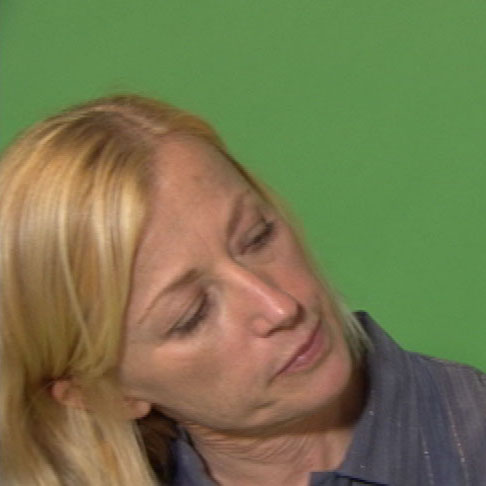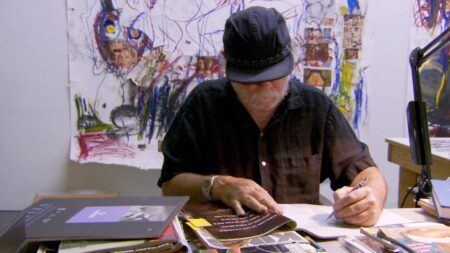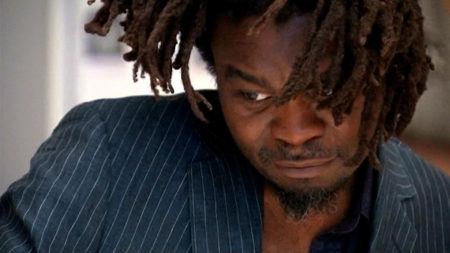Continue playing
(Time remaining: )
Play from beginning
Continue playing "{{ controller.videos[controller.getVideo(controller.currentVideo)].segmentParentTitle}}"
{{controller.videos[controller.getVideo(controller.currentVideo)].title}} has ended.
Cindy Sherman in "Transformation"
“I didn’t want to make what looked like art,” Cindy Sherman says about her earliest works, explaining that “film has always kind of been more influential to me than the art world.”
The segment surveys thirty years of untitled works in which the artist photographs herself in various scenes and guises, grouped into informally-named series such as fairy tales, centerfolds, history portraits, Hollywood/Hampton types, and clowns.
Sherman used a digital camera and green screen for her most recent series of society portraits, modifying each image’s “background with the same kind of license that a painter would take.” Sorting through test shots at the computer, Sherman leads the viewer through her iterative process.
The segment later follows her to a thrift store where, upon finding several “wacky pants” she wonders if this shopping trip “might be inspiring a whole new series.”
Credits
Created by: Susan Sollins & Susan Dowling. Executive Producer & Curator: Susan Sollins. Series Producer: Eve-Laure Moros Ortega. Associate Producer: Migs Wright. Associate Curator: Wesley Miller. Production Manager: Nick Ravich. Production Coordinator: Larissa Nikola-Lisa. Consulting Director: Charles Atlas. Editor: Lizzie Donahue. Director of Photography: Philippe Charluet, Bob Elfstrom, Richard Numeroff, Ian Serfontein, & Joel Shapiro. Sound: Mark Cornish, Doug Dunderdale, Roger Phenix, Paul Stadden, & Merce Williams. Assistant Camera: Gideon Jennings, Clair Popkin, Michael Pruitt-Bruun, Adriano Vasquez, & Claudia Woloshin. On Screen Interviews: Ann Marie Peña & Damon McCarthy.
Creative Consultant: Ed Sherin. Art Direction & Design: Open, New York. Graphics Animation: Maurice Caicedo & Urosh Perishic. On-Line Editor: Don Wyllie. Composer: Peter Foley. Voice-Over Artist: Jace Alexander. Sound Editing: Margaret Crimmins & Greg Smith. Sound Mix: Cory Melious. Artwork Animation: Frank Ferrigno. Assistant Editor: Ahmed Amer, Janine Cappadona, Paulo Padilha, Joaquin Perez, Leana Siochi, & Ken Yapelli.
Artworks Courtesy of: Paul McCarthy; Cindy Sherman; Yinka Shonibare MBE; Hauser & Wirth, Zürich, London, New York; James Cohan Gallery, New York; Metro Pictures, New York; & Stephen Friedman Gallery, London.
Special Thanks: The Art21 Board of Trustees; Michael Ashburn; Amy Baumann; Travis Call; Pat Casteel and Steve Wylie; Ginger Cofield; Ralph Cuccurullo; Jon Dawe; Dog Bark Sound; Kym Elphinstone; Frame:Runner, NYC; Thomas Harris; Tom Heman; Naotaka Hiro; Rachel Kent; Angela Kunicky; Mark Lan; Margaret Lee; Sheila Lynch; The McCarthy family; Craig McIntyre; Memorial Sloan-Kettering Cancer Center Thrift Shop; Museum of Contemporary Art, Sydney; The National Gallery of Victoria, Sydney; Paul McCarthy Studio, Los Angeles; Christopher Rawson; Andre Ribuoli; Ann-Marie Rounkle; Susan Schneider; Keith Shapiro; Skarstedt Gallery, New York; Leily Soleimani; Jessica Sonders; Sound Lounge; Lauri Stern; Jacobine Van Der Meer; Kara Vander Weg; Tony Volante; Whitney Museum of American Art, New York; James Woodward; & John Wyver.
Additional Art21 Staff: Beth Allen, Mary Cook, Joe Fusaro, Jessica Hamlin, Jennifer H. Lee, Marc Mayer, Jonathan Munar, Katherine Payne, Kelly Shindler, & Sara Simonson.
Interns: Maggie Bordonaro, Krystle DeMauro, Natalia P. Good, Sophie Grant, Pinchang Huang, Joy Lai, Rachele Lam, Jamie Leonardi, Melanie K. Mambo, Pauli Ochi, Sara Odam, David Roesing, Nicole Ross, Nicole Sansone, & Julia Wright.
Public Relations: Goodman Media International. Station Relations: De Shields Associates, Inc. Legal Counsel: Albert Gottesman. Bookkeeper: Valerie Riley. Travel Agent: Lita Gottesman.
Major underwriting for Art in the Twenty-First Century Season Five provided by: National Endowment for the Arts; Public Broadcasting Service; Agnes Gund; Bloomberg; The Nathan Cummings Foundation; The Andy Warhol Foundation for the Visual Arts; The Broad Art Foundation; Korea Foundation; & The Horace W. Goldsmith Foundation.
Closed captionsAvailable in English, German, Romanian, Italian, Japanese, Korean, Chinese, Italian
Through the Art21 Translation Project, multilingual audiences from around the globe can contribute translations, making Art21 films more accessible worldwide. Translate this video now.
Interested in showing this film in an exhibition or public screening? To license this video please visit Licensing & Reproduction.
In self-reflexive photographs and films, Cindy Sherman invents myriad guises, metamorphosing from Hollywood starlet to clown to society matron. Often with the simplest of means—a camera, a wig, makeup, an outfit—Sherman fashions ambiguous but memorable characters that suggest complex lives that exist outside of the frame. Leaving her works untitled, Sherman refuses to impose descriptive language on her images—relying instead on the viewer’s ability to develop narratives. While rarely revealing her private intentions, Sherman’s investigations have a compelling relationship to public images, from kitsch to art history to green-screen technology.
“I didn’t want people to have a preconceived notion of what they’re supposed to imagine this character to be.”
Cindy Sherman
More from "Transformation"
Artist at Work
Cindy Sherman
Cindy Sherman
Cindy Sherman




